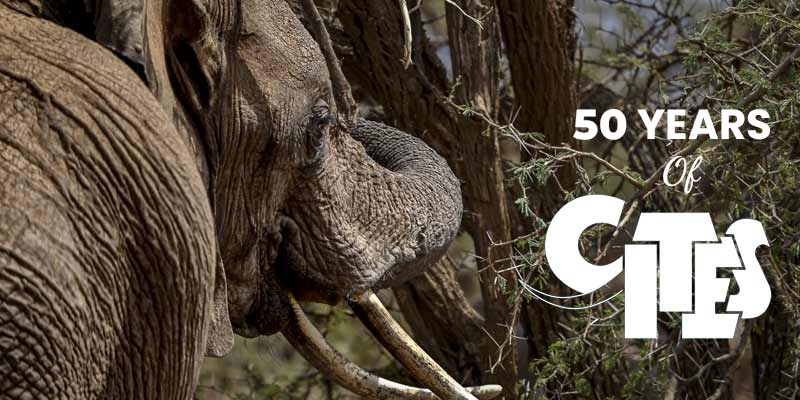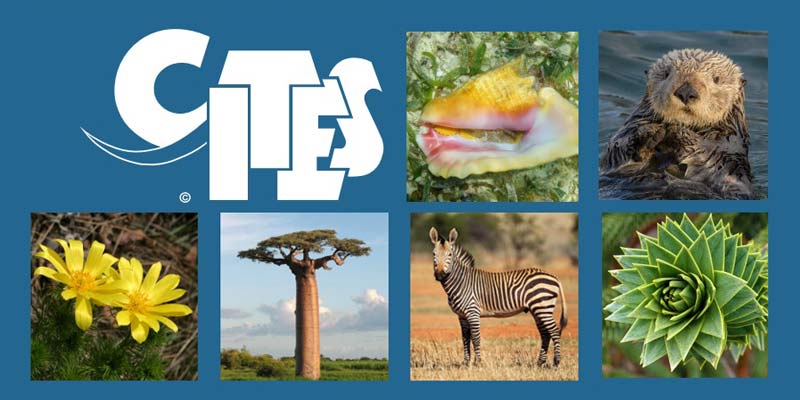- World
- Jul 02
Explainer - 50 years of CITES
The Convention on International Trade in Endangered Species of Wild Fauna and Flora (CITES) entered into force 50 years ago on July 1, 1975.
It marks five decades of protecting endangered wildlife from overexploitation through international trade.
What is CITES?
• The Convention on International Trade in Endangered Species of Wild Fauna and Flora, known as CITES or the Washington Convention, was signed on March 3, 1973 and entered into force on July 1, 1975.
• Originally conceived in 1963 at a meeting of the International Union for Conservation of Nature, the Convention entered into force as the first global agreement of its kind.
• With 185 Parties (184 countries and the European Union), it remains one of the world’s most powerful tools for wildlife conservation through the regulation of international trade in over 40,000 species of wild animals and plants.
• India is a Party to the CITES since 1976.
• The CITES Secretariat is administered by the United Nations Environment Programme (UNEP), and is located at Geneva, Switzerland.
• Annually, international wildlife trade is estimated to be worth billions of dollars and to include hundreds of millions of plant and animal specimens. The trade is diverse, ranging from live animals and plants to a vast array of wildlife products derived from them, including food products, exotic leather goods, wooden musical instruments, timber, tourist curios and medicines.
• Levels of exploitation of some animal and plant species are high and the trade in them, together with other factors, such as habitat loss, is capable of heavily depleting their populations and even bringing some species close to extinction.
• Many wildlife species in trade are not endangered, but the existence of an agreement to ensure the sustainability of the trade is important in order to safeguard these resources for the future.
• CITES seeks to ensure that international trade in such species is sustainable, legal and traceable and contributes to both the livelihoods of the communities that live closest to them and to national economies for a healthy planet and the prosperity of the people in support of UN Sustainable Development Goals.
• CITES regulates international trade in specimens of species of wild fauna and flora based on a system of permits and certificates issued under certain conditions.
• It covers export, re-export, import and landing from the high seas of live and dead animals and plants and their parts and derivatives.
How CITES works?
• CITES works by subjecting international trade in specimens of selected species to certain controls.
• All import, export, re-export and introduction from the sea of species covered by the Convention has to be authorised through a licensing system.
• Each Party to the Convention must designate one or more management authorities in charge of administering that licensing system and one or more scientific authorities to advise them on the effects of trade on the status of the species.
CITES accords varying degrees of protection to more than 40,000 species of animals and plants by applying different provisions to species included in three Appendices.
i) Appendix I includes species threatened with extinction. CITES prohibits international trade in specimens of these species except when the purpose of the import is not commercial, for instance for scientific research.
ii) Appendix II includes species not necessarily threatened with extinction, but in which trade must be controlled in order to avoid utilisation incompatible with their survival. It also includes so-called “look-alike species”, that is species whose specimens in trade look like those of species listed for conservation reasons.
iii) Appendix III contains species that are protected in at least one country, which has asked other CITES Parties for assistance in controlling the trade. International trade in specimens of species listed in this Appendix is allowed only on presentation of the appropriate permits or certificates.
• Species may be added to or removed from Appendix I and II, or moved between them, only by the Conference of the Parties (CoP).
• At each regular meeting of the CoP, Parties submit proposals based on those criteria to amend these two Appendices I and II. Those amendment proposals are discussed and then submitted to a vote.
• Changes to Appendix III follow a distinct procedure from changes to Appendices I and II, as each Party is entitled to make unilateral amendments to it.
Why CITES matters?
• International wildlife trade is now worth billions of dollars, and unregulated trade — alongside habitat loss and overexploitation — continues to drive vulnerable species towards extinction.
• Because such trade spans borders, international cooperation is critical.
• CITES has established itself as one of the most effective multilateral environmental agreements by developing consensus-based governance and implementation tools such as the CITES Trade Database — the world’s most comprehensive source of global wildlife trade data — and guidelines for legal acquisition, permitting and enforcement.
• Thanks to the Convention, international collaboration has brought critically endangered species from the brink, like African elephants, pangolin and crocodiles.
• A key initiative, the Monitoring the Illegal Killing of Elephants (MIKE) Programme, operates at over 70 sites across Africa and Asia, covering roughly half of the pachyderm population. MIKE data has contributed to a downward trend in illegal killings, especially in Africa.
• CITES complements the work of other UN entities, such as the Food and Agriculture Organisation (FAO) to improve fisheries management, capacity building and technical cooperation with the Economic and Social Commission for Asia and the Pacific (ESCAP), and initiatives focusing on the youth with the UN Development Programme.
Manorama Yearbook app is now available on Google Play Store and iOS App Store


